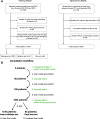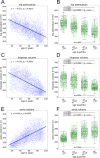TotalSegmentator: Robust Segmentation of 104 Anatomic Structures in CT Images
- PMID: 37795137
- PMCID: PMC10546353
- DOI: 10.1148/ryai.230024
TotalSegmentator: Robust Segmentation of 104 Anatomic Structures in CT Images
Abstract
Purpose: To present a deep learning segmentation model that can automatically and robustly segment all major anatomic structures on body CT images.
Materials and methods: In this retrospective study, 1204 CT examinations (from 2012, 2016, and 2020) were used to segment 104 anatomic structures (27 organs, 59 bones, 10 muscles, and eight vessels) relevant for use cases such as organ volumetry, disease characterization, and surgical or radiation therapy planning. The CT images were randomly sampled from routine clinical studies and thus represent a real-world dataset (different ages, abnormalities, scanners, body parts, sequences, and sites). The authors trained an nnU-Net segmentation algorithm on this dataset and calculated Dice similarity coefficients to evaluate the model's performance. The trained algorithm was applied to a second dataset of 4004 whole-body CT examinations to investigate age-dependent volume and attenuation changes.
Results: The proposed model showed a high Dice score (0.943) on the test set, which included a wide range of clinical data with major abnormalities. The model significantly outperformed another publicly available segmentation model on a separate dataset (Dice score, 0.932 vs 0.871; P < .001). The aging study demonstrated significant correlations between age and volume and mean attenuation for a variety of organ groups (eg, age and aortic volume [rs = 0.64; P < .001]; age and mean attenuation of the autochthonous dorsal musculature [rs = -0.74; P < .001]).
Conclusion: The developed model enables robust and accurate segmentation of 104 anatomic structures. The annotated dataset (https://doi.org/10.5281/zenodo.6802613) and toolkit (https://www.github.com/wasserth/TotalSegmentator) are publicly available.Keywords: CT, Segmentation, Neural Networks Supplemental material is available for this article. © RSNA, 2023See also commentary by Sebro and Mongan in this issue.
Keywords: CT; Neural Networks; Segmentation.
© 2023 by the Radiological Society of North America, Inc.
Conflict of interest statement
Disclosures of conflicts of interest: J.W. No relevant relationships. H.C.B. No relevant relationships. M.T.M. No relevant relationships. M.P. No relevant relationships. D.H. No relevant relationships. A.W.S. No relevant relationships. T.H. No relevant relationships. D.T.B. No relevant relationships. J.C. No relevant relationships. S.Y. No relevant relationships. M.B. No relevant relationships. M.S. No relevant relationships.
Figures







References
-
- Sevilla J , Heim L , Ho A , Besiroglu T , Hobbhahn M , Villalobos P . Compute trends across three eras of machine learning . arXiv 2202.05924 [preprint] https://arxiv.org/abs/2202.05924. Posted February 11, 2022. Accessed November 2022 .
-
- Suzuki K . Overview of deep learning in medical imaging . Radiol Phys Technol 2017. ; 10 ( 3 ): 257 – 273 . - PubMed
-
- McBee MP , Awan OA , Colucci AT , et al. . Deep learning in radiology . Acad Radiol 2018. ; 25 ( 11 ): 1472 – 1480 . - PubMed
LinkOut - more resources
Full Text Sources
Other Literature Sources

